World health day 2022: Seven calls to action to protect "our planet, our health"
Lessons from the SALURBAL Project
Posted on
April 7, 2022
By: Katy Indvik
SALURBAL Project
“Are we able to reimagine a world where clean air, water and food are available to all?
Where economies are focused on health and well-being?
Where cities are livable, and people have control over their health and the health of the planet?”
World Health Organization: World Health Day 2022, “Our planet, our health”
For just over five years, the SALURBAL team has worked to improve our understanding of urban health and health inequities across Latin America. As we mark this year’s World Health Day, we reflect on some of our key findings and how they can help drive action to address some of the greatest threats facing our health and our planet.
1. DIVERSITY is our strength, but our cities are also marked by stark inequalities
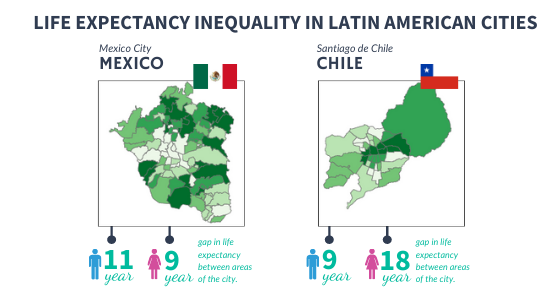
Source: Bilal et al., Lancet Planetary Health, 2019
Our researchers mapped out the extreme magnitude of inequalities in life expectancy for a group of cities in Latin America and documented the relationship between life expectancy and local socioeconomic status. Differences in life expectancy between areas with the highest and lowest education levels were as high as eight years for men and twelve years for women.
SALURBAL researchers have also found that cities with higher income segregation have higher rates of homicides, inequality, and poverty – and that residential segregation may play a role in creating racial health inequities.
Our results highlight the importance of developing urban policies focused on reducing social inequalities and improving social and environmental conditions in the poorest neighborhoods of Latin American cities.
2. Understanding the way urban factors affect our most VULNERABLE POPULATIONS can inform policies that benefit everyone
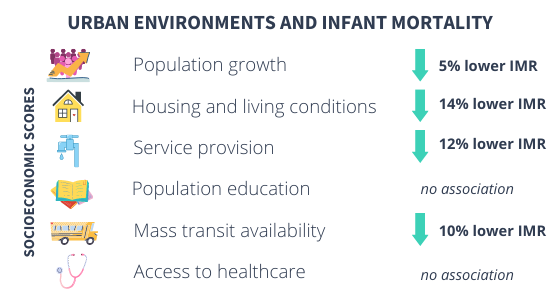
Source: Ortigoza et al., Cities & Health, 2021
Ortigoza et al., Epidemiology & Community Health, 2020
Despite steady declines in infant mortality in Latin America since the 1950s, reductions in preventable infant deaths have stalled in recent years, and rates of infant mortality in some cities and countries remain high. Many of these deaths are avoidable. SALURABL’s MAPECA working group generates evidence about urban determinants of health inequalities among women, children, and youth in Latin American cities. These findings can inform policy by helping decision-makers allocate available resources to the interventions that are most likely to improve health outcomes.
3.We are still processing connections between COVID-19 and URBAN HEALTH INEQUITIES
Early in the pandemic, SALURBAL researchers began tracking the COVID-19 pandemic in Latin American countries, cities, and neighborhoods. An interactive online dashboard allows visitors to plot trends of COVID-19 cases and deaths, to map these outcomes at various geographic levels, and to compare the progress of the pandemic across countries.
Our researchers have also been studying the ways COVID-19 has increased health inequities in cities like Santiago, Chile; the impact of shutdowns on urban air pollution; the impact of emergency responses like temporary bike lanes; and some of the unintended consequences of lock downs and park use restrictions in the region.
These and other findings can help us understand whether sub-city mobility restrictions were effective at reducing COVID-19 transmission. Our results also raise important questions about the people who are most negatively affected by these and other pandemic response measures.
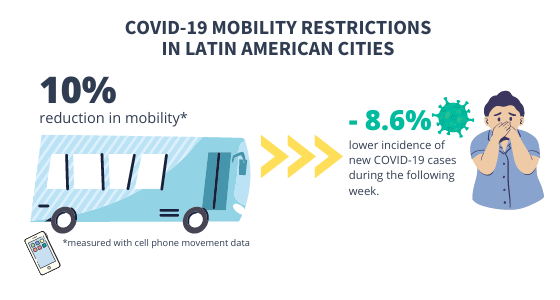
Source: Kephart et al., The Lancet Digital Health, 2021
4.We know more and more about how the URBAN BUILT ENVIRONMENT determines people’s health and wellbeing
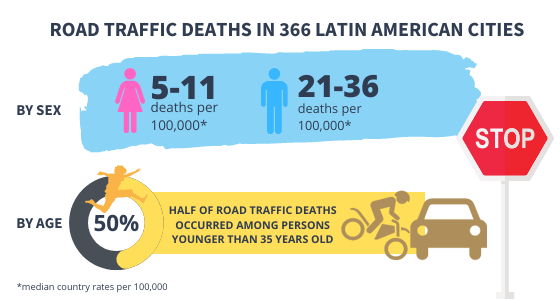
Source: Quistberg et al., The Lancet Planetary Health, 2022
Road-traffic injuries are an important cause of death across Latin America, but rates vary greatly both across and within cities and countries, by sex, and by age. Until now, very few studies have examined the role of city-level characteristics on road-traffic mortality. Our researchers found more traffic-related deaths in cities with more isolated urban development. Urban areas with higher population density, GDP, intersection density, and mass transit systems had lower road-traffic mortality.
These results provide clear evidence to support urban policies that target isolated urban development, promote walkable street networks, and prioritize public transport – and highlight the human costs of failing to invest in these changes.
These types of policies can provide other benefits, too. Improving public and active transport safety, reliability, and accessibility can help people increase their physical activity and played an important role in cities’ responses to the COVID-19 pandemic.
5. URBAN GREENSPACE is critical for healthy – and equitable – urban planning
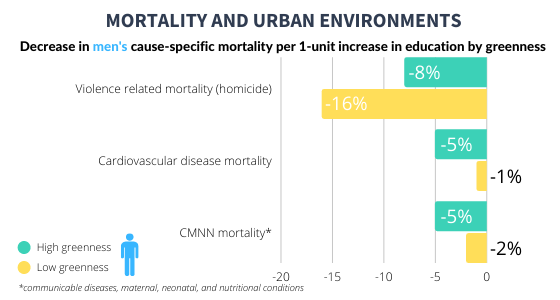
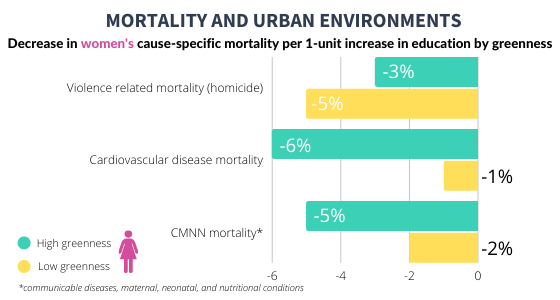
Source: Moran et al., Health Place, 2021
Greenspaces directly benefit health in many ways while also helping mitigate environmental hazards such as air pollution and heat, indirectly reducing the risk for related health conditions. SALURBAL researchers are also documenting the ways that greenspaces interact with other city characteristics to determine health outcomes and health inequalities. For example, among women, higher educational attainment played a more important role in reducing cardiovascular deaths in areas with higher greenness than it did in areas with lower greenness. (In other words, differences in greenness are associated with greater socioeconomic inequalities in cardiovascular death in women.)
We already know that urban green spaces are often concentrated in affluent areas, leaving low-income communities with limited access. These results are therefore important for driving policies to promote more equitable distribution of greenspace to address socioeconomic inequalities in health outcomes such as well-being, physical activity, and obesity.
6. The CLIMATE CRISIS is also a health equity crisis
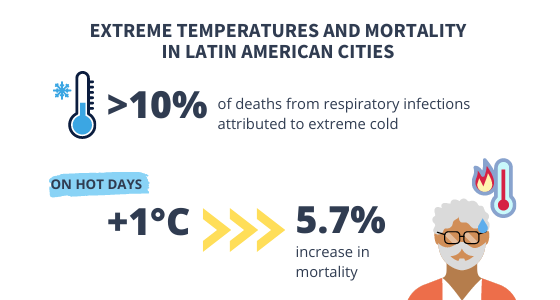
Source: Kephart et al., Nature Medicine, 2022 (In press)
In the context of increasingly urgent warnings about the health impacts of climate change and our narrowing window for mitigation action, our team is shifting attention toward the impacts of climate change on health and health equity.
Extreme heat has caused more deaths this century than those related to hurricanes, lightning, tornadoes, floods, and earthquakes combined. Climate change will increase the frequency, duration, and intensity of extreme heat events, and will contribute to additional heat-related deaths. Understanding these connections is important for predicting the impacts of heatwaves on health and mortality, and for informing urban decision-makers, first responders, and other actors about ways to address and prevent the health impacts of extreme heat.
7. Systemic problems require SYSTEMIC SOLUTIONS
As we face unprecedented and overwhelming threats to our social, economic, political, and planetary systems, we continue to improve our understanding the ways these interconnected structures and processes work together to determine our health and wellbeing. In the same way, responses to these challenges must come from multiple sectors, from cities across the globe, and from groups up of people with different perspectives and experiences. On this World Health Day 2022, the SALURBAL team joins voices from across the globe in the WHO’s call to ambitious action to safeguard our planet, and our health.